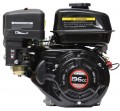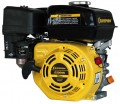Power
The rated power of the engine in horsepower (in fact,
the maximum power that the unit can produce in normal operation, without overloads). Despite the popularity of the designation in watts (see below), horsepower (hp) is still quite widely used to indicate the power of internal combustion engines. 1 HP is approximately 735 watts.
In general, the more powerful the engine, the more speed and tractive effort it is able to develop. On the other hand, this indicator directly affects the weight, dimensions, and most importantly, the cost of the unit, while the real need for high power is relatively rare. Therefore, it is worth choosing according to this indicator, taking into account the features of the planned application; specific recommendations on the selection of an engine for a specific technique and tasks can be found in special sources. We only note that models of the same power can differ in speed and "torque"; see "Shaft speed" for details.
In general, performance up to 8 hp. are considered low, up to 13 hp. — medium, more than 13 hp — high.
Power
The rated power of the engine (the highest power it can deliver in normal operation) in kilowatts. Initially, the power of internal combustion engines (ICE) was usually denoted in horsepower, but now it is also common to record in watts / kilowatts; this, in particular, makes it easier to compare the power of internal combustion engines and electric motors. Some units can be converted to others: 1 hp approximately equal to 0.735 kW.
In general, the more powerful the engine, the more speed and tractive effort it is able to develop. On the other hand, this indicator directly affects the weight, dimensions, and most importantly, the cost of the unit, while the real need for high power is relatively rare. Therefore, it is worth choosing according to this indicator, taking into account the features of the planned application; specific recommendations on choosing an engine for a specific technique and tasks can be found in special sources. We only note that models of the same power can differ in speed and "torque"; see "Shaft speed" for details.
Max. torque
The maximum torque developed by the engine during operation. Note that such an indicator is usually achieved only at certain speeds — this nuance can be specified in the characteristics.
Torque can be simplistically described as the force exerted by a motor on a shaft. The higher this effort, the more “high-torque” the motor is, the better it overcomes resistance and handles with high loads. The torque value is directly related to the power. For example, for 5 hp models. and less torque
up to 10 Nm is considered quite normal, engines of 4 – 7 hp. give out
from 10 to 20 Nm, and values
of 20 Nm or more are found in units with a power of at least 8 hp. At the same time, engines of the same power may differ in actual force. So this indicator characterizes the capabilities of the unit well in comparison with analogues.
It is worth saying that many consider torque to be a more reliable and visual parameter than power: the latter can be indicated in different ways (nominal, maximum, etc.), while torque is a completely unambiguous characteristic.
Shaft speed
The highest shaft speed provided by the motor. Before buying, you should make sure that this indicator corresponds to the characteristics of the equipment in which you plan to install the engine — too high a speed can damage the working tool, transmission units, etc.
It is also worth considering that a higher rotational speed (for the same engine power and transmission characteristics) means less torque, and vice versa. Therefore, this parameter allows you to compare engines in terms of the speed / thrust ratio (however, only on the condition that they do not have reduction gears — see "Functions").
Shaft length
It is customary to call the shaft length only the length of its outer part protruding beyond the engine housing. The optimal value of this parameter depends on the characteristics of the machine in which the engine is planned to be installed.
Shaft diameter
The diameter of the motor shaft, more precisely, the diameter of its outer part, located behind the housing. Data on the diameter of the shaft is needed to clarify the compatibility of the engine with the mechanism for which it is bought.
Now on the market there are shafts with the following diameters:
16 mm,
19 mm,
20 mm,
22 mm,
25 mm.
Fuel consumption
Nominal fuel consumption during engine operation. This indicator allows you to evaluate, first of all, the efficiency of the unit and the costs of its operation. And having data on the volume of the fuel tank, you can also calculate the time of continuous operation on a single refill. However, it should be taken into account that in the characteristics the fuel consumption is usually indicated for a certain average operating mode, and in fact it can be more, especially when using the engine in difficult conditions. However, according to these data, it is quite possible to compare different engine models.
Noise level
The noise level produced by the engine during operation. This parameter is quite approximate, because. the characteristics usually indicate a certain average value. And in some situations (for example, a sharp increase in the load on the shaft), the noise can increase noticeably. Also, do not forget that the components and mechanisms of the machine in which the engine is installed also produce a certain noise, which is added to the noise of the engine. However, the less noise the motor produces, the more comfortable it is, usually, to use it.
The noise level is usually measured in decibels; this is a non-linear value, so it is easiest to evaluate the volume using comparative tables that can be found in special sources. The most "quiet" general purpose engines give out about 70 dB, this can be compared with the passage of a truck at a distance of 8 – 10 m; the loudest are just under 100 dB (subway train noise).

